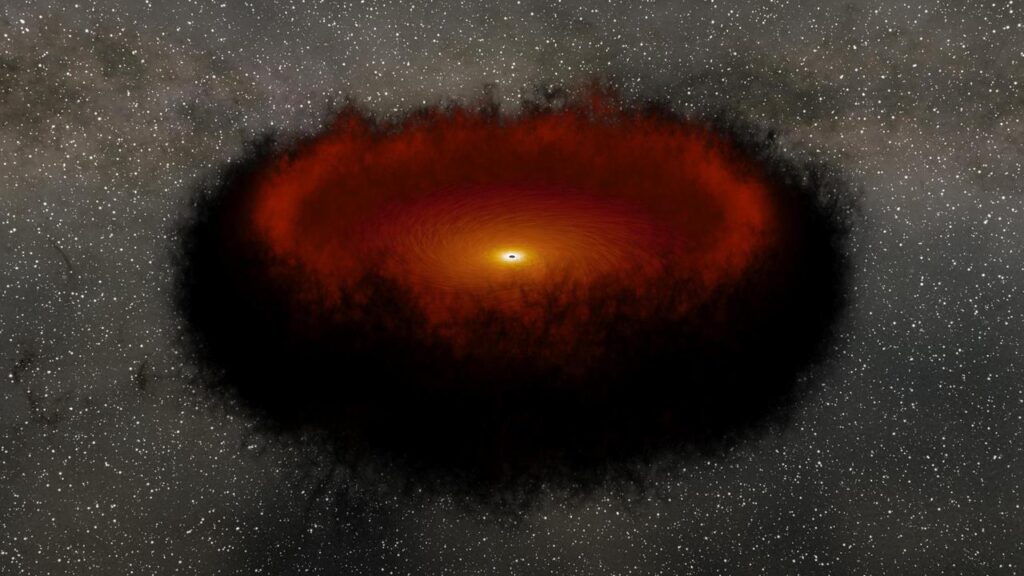Fast Radio Bursts (FRBs) offer a profound opportunity to understand the vast reaches and the fundamental properties of the universe. The recent detection of FRB 20220610A, which traveled approximately 8 billion light years to reach us, highlights the potential of FRBs as tools to map the distribution of intergalactic plasma and refine our understanding of the universe's total mass. This breakthrough provides crucial insights into the cosmic structures and challenges existing theories about the universe's expansion and fate.
Posts published in “Astronomy”
Discover the findings from a new study that sheds light on the origins of the most significant marsquake ever recorded on the Red Planet, exploring what it reveals about Mars' internal structure and geological activity.
Explore the startling discovery of young stars forming in close proximity to the Milky Way’s supermassive black hole, Sgr A*. This intriguing phenomenon challenges established theories of stellar evolution and offers new insights into the dynamics at the heart of our galaxy.
In recent advancements, Ad Astra Rocket Company has successfully tested its Vasimr VX-200SS plasma rocket, achieving a new endurance record for high-power electric propulsion. This development could significantly shorten the journey time to Mars, enhancing safety and reducing exposure to space hazards for astronauts.
As humanity gears up for the next significant leap in space exploration with NASA's Artemis III mission, the spotlight turns not just to astronauts but also to the innovative infrastructure that will support them. The recent announcement of selecting Northrop Grumman to develop a moon-based railroad network underlines a strategic shift from isolated efforts to a cohesive, resource-sharing ecosystem. This railroad network is envisioned as the backbone of lunar logistics, supporting the transportation of humans, supplies, and resources across the Moon. It's a bold step toward creating a scalable, efficient, and interconnected lunar economy, essential for the long-term presence humans hope to establish.
NASA's Mars Sample Return mission has undergone significant revisions due to budget constraints and technical challenges. Originally planned for a 2031 return, the mission is now aiming for 2040 with a simplified, cost-effective strategy. This article explores the implications of the revised plan, focusing on the mission's goals, the scientific importance of the Martian samples, and NASA's innovative approaches to overcoming the obstacles of interplanetary exploration.
In a fortuitous twist of fate, astronomers using data from the European Space Agency's Gaia mission have discovered the largest stellar black hole in the Milky Way, named Gaia BH3, which boasts a mass 33 times that of our sun and resides in the Aquila constellation. This groundbreaking find not only advances our understanding of stellar remnants but also highlights the unexpected surprises still lurking in our galaxy.
NASA's innovative response to dust challenges in space is the Electrodynamic Dust Shield (EDS), a technology designed to protect astronauts and equipment from the abrasive and hazardous regolith found on the Moon and Mars. Using transparent electrodes and electric fields, the EDS effectively removes dust from surfaces, ensuring the efficiency and safety of space missions. The technology has been tested in vacuum chambers and aboard the International Space Station, showing promising results for future lunar and Martian expeditions.
Recent research suggests that neutron stars may capture dark matter, which could significantly affect their thermal properties and evolution. If dark matter particles interact with each other or decay, they might release energy that could heat neutron stars from the inside, making them appear hotter than they otherwise would be. This phenomenon offers a unique method to detect dark matter indirectly and understand its properties, providing a new perspective on the universe's most elusive matter.
Discover the groundbreaking potential of deploying a swarm of tiny probes to Proxima Centauri B. This innovative approach could revolutionize our understanding of our closest exoplanetary neighbor, offering unparalleled insights into its atmosphere, surface, and the possibility of life beyond Earth. Join us as we explore how this fleet of microprobes could unlock the secrets of the cosmos, marking a new era in interstellar exploration.
Explore the fascinating journey of stars as they transition from the main sequence to becoming white dwarfs, and uncover the dramatic effects this transformation has on their planetary systems. From the engulfing of inner planets to the survival of distant worlds, this deep dive reveals the cosmic ballet of destruction and survival, shedding light on the enduring legacy of stars long after their light fades.
Embark on a celestial journey from 2026 to 2028, as we explore the majestic total solar eclipses gracing Greenland, Iceland, Spain, North Africa, and Australia. Discover the unique dance of shadows that transforms day into night and learn how to safely witness these awe-inspiring events. Whether you're a seasoned eclipse chaser or new to the phenomenon, the upcoming eclipses offer a world of adventure and wonder. Prepare to be captivated by the cosmic ballet that awaits.












